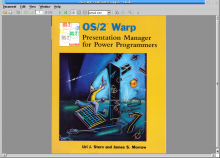OS/2 Warp Presentation Manager for Power Programmers - Uri Joseph Stern, James Stan Morrow
This book will concentrate on programming the OS/2 Presentation Manager subsystem.
The Presentation Manager GUI interface was first introduced with version 1.1 of OS/2 in late October 1988, and, like the operating system itself, it has grown and matured with each release. Versions 1.2 and 1.3 of the operating system introduced the Help Manager and an enhanced controls library, including items such as the combobox and the spin button. Version 2.0 introduced a radical new graphical user interface on top of the Presentation Manager, known as the Workplace Shell; and new advanced controls, including the container, the notebook, the value set, and the linear slider.
The multimedia presentation manager (MMPM), which had been available separately, began shipping as a part of OS/2 with the release of version 2.1. This provided programmers with powerful new multimedia controls, such as the graphical button and circular slider, as well as secondary windows and message boxes. Version 3.0, or OS/2 WARP, is primarily a performance release. The main body of the Presentation Manager has been converted to 32-bit code and a number of enhancements have been added to the existing library set. New features include pickup-and-drop direct manipulation support and distributed SOM technology.
OS/2 itself is a complete, 32-bit multitasking operating system for personal computers. The system supports multiple threads of execution in each application and provides preemptive multitasking on a thread basis. Various forms of interprocess and interthread communication are available, including shared memory, queues, and semaphores. Utilization of the memory management features of the Intel 386/486 processor family prevents processes from inadvertently corrupting the memory of other processes, and the operating system's l/O architecture prevents corruption when multiple processes attempt to communicate with the same device simultaneously.
OS/2 is gaining acceptance, and more software developers are realizing the potential for writing OS/2 PM-based applications.
The Presentation Manager Graphical User Interface, or PM, provides advanced mechanisms for user interaction and allows multiple processes to share the video display, keyboard, and pointing device that comprise the system console. In addition to managing the user interface, PM provides facilities for displaying and manipulating graphical information and supplies the programmer with a rich set of predefined controls for interacting with the user. But PM is not a rigid system, it provides facilities that allow the programmer to modify the function of the existing controls, create new controls, and extend the functionality of the user interface.
While the basic concepts and programming techniques have remained the same, many new features have been added with each new release of Presentation Manager. Applications that take advantage of these new features typically provide an interface that is easier to understand and use than applications that are programmed exclusively with the early features. This book, written with the assumption that the reader is already familiar with the basics of Presentation Manager programming, provides an in-depth study of the features available with the Warp release of OS/2.
This release provides a powerful, fast user interface that is essential for good graphical programming; it is one of the best in the industry.
Quite simply, OS/2 Warp is the "Elvis" of operating systems.


This work is licensed under a Creative Commons Attribution 4.0 International License.
Add new comment